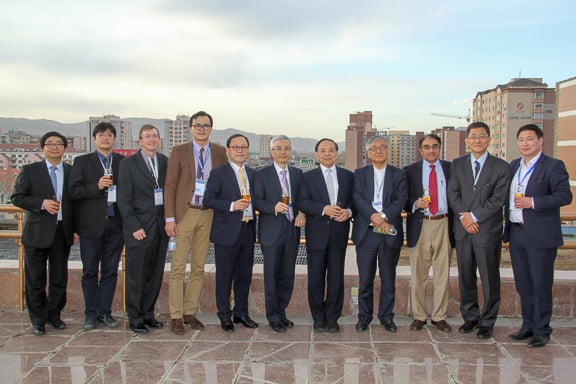Dr. Young Kim Lectures in Mongolia
 |
 |
by Young Kim, MD
I just returned from my second visit to Mongolia. Mongolia has the world’s highest mortality rate from hepatocellular carcinoma (HCC). In addition, most Mongolian patients with HCC are diagnosed at an advanced stage due to limited resources in health care. The Mongolian government started a nation-wide Hepatitis B immunization program in 1991, and achieved an immunization failure rate of only 0.3% in children less than 5 years old. Unfortunately, the number of patients with Hepatitis C is on the rise primarily due to a lack of awareness of blood safety, equipment disinfection, and needle re-use. In addition, due to the nation-wide excessive consumption of alcohol and the increasing number of people with diabetes and obesity, the incidence of HCC has become the highest in the world in the last decade. While there are many medical treatment options for Hepatitis C, it is far beyond the budget and ability of the government to provide this treatment. Furthermore, diagnostic screening for hepatitis through blood tests or imaging modalities such as US, CT or MR are not readily available. There are also curative or palliative treatment options for early HCC such as alcohol injection, radiofrequency ablation (RFA), transarterial chemoembolization (TACE), and surgery. However, a lack of funding at the private and government levels in combination with the paucity of well-trained physicians and equipments, many of these patients will not have a chance to receive any of these treatments.
To address these medical issues I co-organized with Undrakh-Erdene Erdenebold, the president of the Mongolian Society of Interventional Radiology and a Fulbright Scholar, an international meeting with the agenda of “Liver Cancer Imaging and Intervention” which has successfully held on April 29, 2016 with 20 international guest speakers with 167 doctors from all over the Mongolia. The conference was to find the “Best Practice Model in Mongolia” with the objective of achieving sustainable and practical methods to tackle the high incidence of HCC in Mongolia. Mongolia does not stand alone in this increasing worldwide epidemic of hepatitis and HCC. Many of us at the conference want to work towards a tailored solution while taking into account each individual country’s incidence and resources through continued education, research, collaboration and dedication.
It was nice to meet former visiting fellow from Mongolia, Dr Zaya Duisyenbi. She has a very pleasant memory of her stay at UMass and wants to thank everyone! Dr Duisyenbi stated that her two month experience at UMass greatly enhanced her knowledge and performance as a radiologist in many aspects.
It was nice to meet friends and mentors in Ulanbaatar. I had an opportunity to enjoy a delicious lamb chop, a quality that is hard to find in the US or any other place I’ve been to. It was also great to meet the former Chairman of our department, Dr Krishna Kandarpa, who now takes on an important role at the NIH. Krishna contributed not only by giving an excellent lecture but he also donated 180 volumes of his famous “Handbook of Interventional Radiologic Procedure” to the participants. He was the most popular and busiest guest speaker at the reception.
I gave two HCC lectures to the physician attendees. I also gave three additional lectures on the clinical application of CT to 168 radiology technologists in Mongolia. Due to this CME course, I could not join a day trip with other guest speakers to see the beautiful Mongolian landscape. However, I felt great satisfaction and appreciation from genuine interaction with the audience. It was inspiring to see their enthusiasm to learn.




